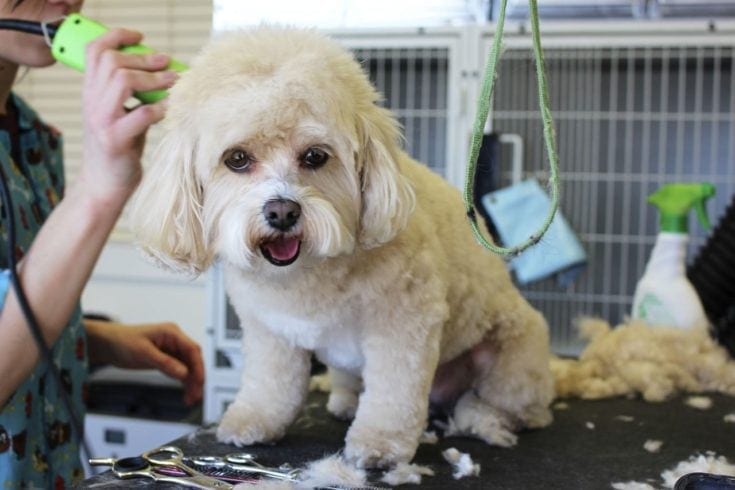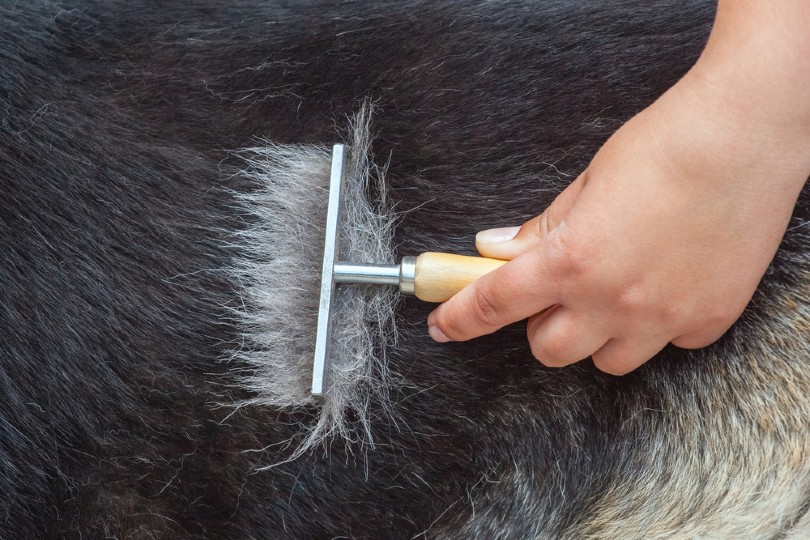Does Shaving a Dog Help with Shedding? Vet-Reviewed Facts & Tips
By Jessica Kim
Updated on

One of the common nuisances that dog owners can deal with is shedding. While it’s impossible to completely prevent shedding from happening (and important to realize that it is a normal, natural process), there are some things you can do to reduce or minimize its appearance in your living space.
One method that doesn’t help with shedding is shaving. Shedding can actually end up causing more harm than good, so it’s best to avoid it as much as possible. There are much more effective solutions that’ll keep your dog safe and your house clean.
Why Shaving Doesn’t Help with Shedding
A dog’s coat doesn’t just provide warmth. Dogs have much thinner and more sensitive skin than we do. So, their fur offers an extra layer of protection from the elements. So, shaving your dog’s coat can risk damaging its skin. A shorter coat leaves the skin more exposed to the sun, which can actually lead to sunburn.
Double-Coated Dogs and Shaving

In general, it’s not a good idea to shave a dog unless it’s for medical emergencies. Shaving is especially harmful to double-coated dogs. Double-coated dogs have two layers of hair. The undercoat is soft and helps dogs stay warm, and the topcoat tends to be coarser.
Dogs will shed their undercoat to cool off when the weather gets warmer. In addition to sunburn protection, the remaining topcoat helps prevent insect bites. Both the topcoat and undercoat also work together to help regulate the dog’s body temperature.
So, if you shave a dog’s double coat, you’d be stripping away the dog’s natural protection and ability to maintain its body temperature. This puts dogs at risk of getting a heat stroke if they’re outside on a hot and sunny day.
A dog’s coat also won’t grow the same after you shave it. The topcoat hair tends to grow slower than the undercoat. You can end up with an uneven distribution of hair that makes your dog appear disheveled. It can take a long time for the hair to grow back to normal, and this can cause more of a headache than regular shedding.
Single-Coated Dogs and Shaving
Single-coated dogs can get shorter haircuts than double-coated dogs. However, they should never be shaved because they still need their hair for protection. You can give your dog a haircut in the summer months to help it stay cool, but the hair length shouldn’t be shorter than an inch.
How To Safely Reduce Shedding
Dog owners have to get used to shedding and finding hair throughout the home. However, this doesn’t mean that your house is doomed to be dirty and messy. There are some things you can do to make shedding manageable and less noticeable.
1. Brush Regularly

One of the best ways to reduce shedding around the home is to regularly brush your dog. Brushing will pick up loose hair from your dog’s coat and help distribute natural oils throughout the skin.
If you have a double-coated dog, you can also use a deshedding tool. Deshedding tools are special types of brushes and combs that help loosen up and pick up undercoat hairs. They’re particularly useful during the shedding season.
When you brush your dog, try to brush it outside of the home or in an isolated area. This will prevent hairs from floating around the home and getting stuck on furniture.
2. Use Moisturizing Shampoo and Conditioner
Baths are a great way to wash away any loose hair, but they can also dry out your dog’s skin. So, make sure to use a shampoo and conditioner with a moisturizing formula to prevent your dog’s skin from drying out and getting irritated.
Dry skin and coat can cause your dog’s hair to become weak and brittle, which makes it more prone to breakage. On top of that, dry skin can cause itchiness and flaking. Pet dander is one of the most common pet allergens, so unhealthy skin and coat can end up exacerbating allergic reactions.
3. Use Skin and Coat Supplements

If you notice that your dog’s skin and coat are chronically dry, you may want to add skin and coat supplements to its diet. These supplements usually contain a type of fish oil that’s packed with omega-3 fatty acids. Not only do omega-3 fatty acids nourish the coat, but they also help with heart and joint health.
Consult with your veterinarian before adding supplements to your dog’s diet. Sometimes, switching to dog food with a skin and coat formula can be more beneficial for your dog. Your veterinarian can determine if supplements, food, and other lifestyle changes are the best course of action for improving your dog’s skin and coat.
Conclusion
Shaving a dog can put a dog at risk of getting sunburn or a heatstroke, so it’s best to avoid shaving altogether. There are plenty of other things you can do to minimize shedding, such as consistent brushing and grooming. These things are much more helpful for your dog, and they’re safer alternatives that won’t put your dog’s health at risk.
Featured Image Credit: KeystonePetPlace, Pixabay













